"I'm Home" vs "I'm at Home": When Each Phrase Works

Written by
Ernest Bio Bogore

Reviewed by
Ibrahim Litinine

The distinction between "I'm home" and "I'm at home" represents more than a simple preposition choice—it reflects fundamental differences in how English speakers conceptualize location, arrival, and emotional connection to space. This grammatical nuance carries significant weight in both casual conversation and professional communication, yet many English learners and even native speakers struggle to apply these phrases correctly.
Understanding when to use each expression requires examining the underlying linguistic principles that govern English spatial relationships. The choice between these phrases isn't arbitrary; it's rooted in whether you're describing a state of being or announcing an arrival, whether you're emphasizing location or emotional connection, and whether the context calls for formal or informal register.
The Core Difference: State vs. Announcement
"I'm home" functions primarily as an announcement of arrival. When someone walks through their front door and calls out "I'm home," they're communicating a change in status—the transition from being elsewhere to being in their personal space. This phrase carries an inherent temporal element; it marks a moment of arrival rather than describing an ongoing condition.
Conversely, "I'm at home" describes a current state of location. If someone calls to ask where you are and you respond "I'm at home," you're providing factual information about your present whereabouts without implying recent arrival. This construction treats "home" as a location noun requiring the preposition "at" to establish the relationship between subject and place.
The temporal distinction becomes clearer when we examine context. "I'm home" typically appears in scenarios involving movement or transition: texting a partner after leaving work, calling out upon entering the house, or updating someone who expected your arrival. "I'm at home" emerges in contexts requiring location clarification: explaining why you can't meet someone, describing your current situation, or responding to questions about availability.
Regional and Cultural Variations
American English strongly favors "I'm home" in most conversational contexts, treating it as the default expression for both arrival announcements and location descriptions. This preference stems from American English's tendency toward directness and economy of language. The phrase has become so standardized that using "I'm at home" in casual American conversation often sounds overly formal or stilted.
British English maintains clearer distinctions between the two phrases, with "I'm at home" remaining common in formal contexts and "I'm home" reserved for arrival announcements. This preservation of distinction reflects British English's general tendency to maintain more formal register options in everyday speech.
Canadian English largely follows American patterns, while Australian and New Zealand English show mixed usage depending on regional influences and formality levels. These variations highlight how geographical factors influence linguistic preferences, even within the same language family.
Formal vs. Informal Contexts
Professional communication typically requires "I'm at home" when describing location. In business emails, conference calls, or formal correspondence, the complete prepositional phrase provides necessary clarity and maintains appropriate register. "I'm working from home today" sounds professional; "I'm home today" might suggest casualness inappropriate for workplace communication.
Academic and technical writing exclusively uses "I'm at home" when describing location states. Research papers, official documents, and instructional materials maintain formal preposition usage to ensure precision and authority. The abbreviated form lacks the gravitas required in these contexts.
Informal contexts, however, embrace "I'm home" for its efficiency and familiarity. Text messages, casual phone calls, and family conversations benefit from the phrase's brevity and emotional warmth. The expression has evolved beyond mere location description to convey comfort, safety, and belonging.
Emotional and Psychological Implications
"I'm home" carries emotional weight that "I'm at home" lacks. The phrase implies connection, belonging, and emotional arrival rather than mere physical presence. When someone says "I'm home," they're often communicating relief, comfort, or happiness about returning to their personal space.
This emotional dimension explains why "I'm home" appears frequently in contexts involving stress relief, end-of-day transitions, or reunion scenarios. The phrase serves as both location update and emotional expression, combining practical information with personal feelings.
"I'm at home" maintains emotional neutrality, focusing purely on spatial relationships without implying feelings about the location. This neutrality makes it appropriate for contexts where emotional expression might be inappropriate or where clarity takes precedence over warmth.
Common Usage Scenarios
Arrival announcements universally employ "I'm home." Whether walking through the door, texting from the driveway, or calling to update travel status, this phrase effectively communicates the transition from away to present. The announcement function requires the abbreviated form because it emphasizes the action of arriving rather than the state of being located.
Location inquiries typically receive "I'm at home" responses in formal contexts. When bosses ask about employee whereabouts, when official forms require location information, or when precise spatial relationships matter, the complete prepositional phrase provides necessary clarity and maintains appropriate tone.
Availability discussions can use either phrase depending on context and relationship. "I'm home tonight" suggests availability and comfort with casual plans, while "I'll be at home this evening" maintains more formal distance and might imply less flexibility.
Grammar Rules and Exceptions
Standard grammar rules dictate that location descriptions require prepositions to establish spatial relationships. "At home," "in the house," and "on the street" follow this pattern by using prepositions to connect subjects with locations. "I'm home" technically violates this rule by omitting the preposition, yet it remains grammatically acceptable due to its widespread adoption and specialized function.
The exception exists because "home" functions uniquely in English, serving as both noun and adverb depending on context. When used adverbially, "home" doesn't require a preposition: "go home," "come home," "stay home." This dual functionality allows "I'm home" to work grammatically as an adverbial construction rather than a prepositional phrase.
Advanced English learners often struggle with this exception because it contradicts general preposition rules they've learned. Understanding that "home" has special status in English helps clarify why both constructions work grammatically while serving different functions.
Professional Communication Guidelines
Business correspondence should default to "I'm at home" when describing location for work purposes. "I'll be working at home tomorrow" maintains professional tone while providing clear information. The complete phrase demonstrates attention to formal language requirements and respect for professional communication standards.
Customer service interactions benefit from formal constructions when location affects service delivery. "I'm at home waiting for the delivery" provides clearer information than "I'm home waiting," particularly in contexts where precision matters for scheduling or logistics.
Academic presentations and formal speeches require complete prepositional phrases to maintain credibility and demonstrate language mastery. Using abbreviated forms in formal academic contexts can undermine speaker authority and distract from content quality.
Digital Communication Patterns
Text messaging has accelerated adoption of "I'm home" across all contexts due to character limits and speed requirements. Even in situations that traditionally required formal language, digital communication often prioritizes efficiency over formal register. This shift reflects broader changes in how technology influences language evolution.
Social media posts predominantly use "I'm home" because the phrase fits platform conventions favoring brevity and emotional expression. The casual nature of most social media content makes formal constructions appear stilted or pretentious.
Email communication shows mixed patterns depending on audience and purpose. Professional emails maintain "I'm at home" while personal emails increasingly adopt "I'm home" regardless of context. This variation reflects email's position between formal business communication and casual personal correspondence.
Teaching and Learning Implications
English language instruction should address both phrases explicitly because their usage patterns don't follow standard grammar rules. Students need specific guidance about when each phrase is appropriate rather than general preposition rules that don't account for "home's" special status.
Advanced learners require nuanced instruction about register, context, and cultural implications rather than simple grammar rules. Understanding that native speakers choose between these phrases based on emotional, social, and professional factors helps learners make appropriate choices in real communication situations.
Practice exercises should include varied contexts requiring different phrase choices to help learners internalize the decision-making process. Role-playing scenarios, contextual gap-fills, and register-awareness activities provide more effective learning opportunities than traditional grammar drills.
Learn Any Language with Kylian AI
Private language lessons are expensive. Paying between 15 and 50 euros per lesson isn’t realistic for most people—especially when dozens of sessions are needed to see real progress.
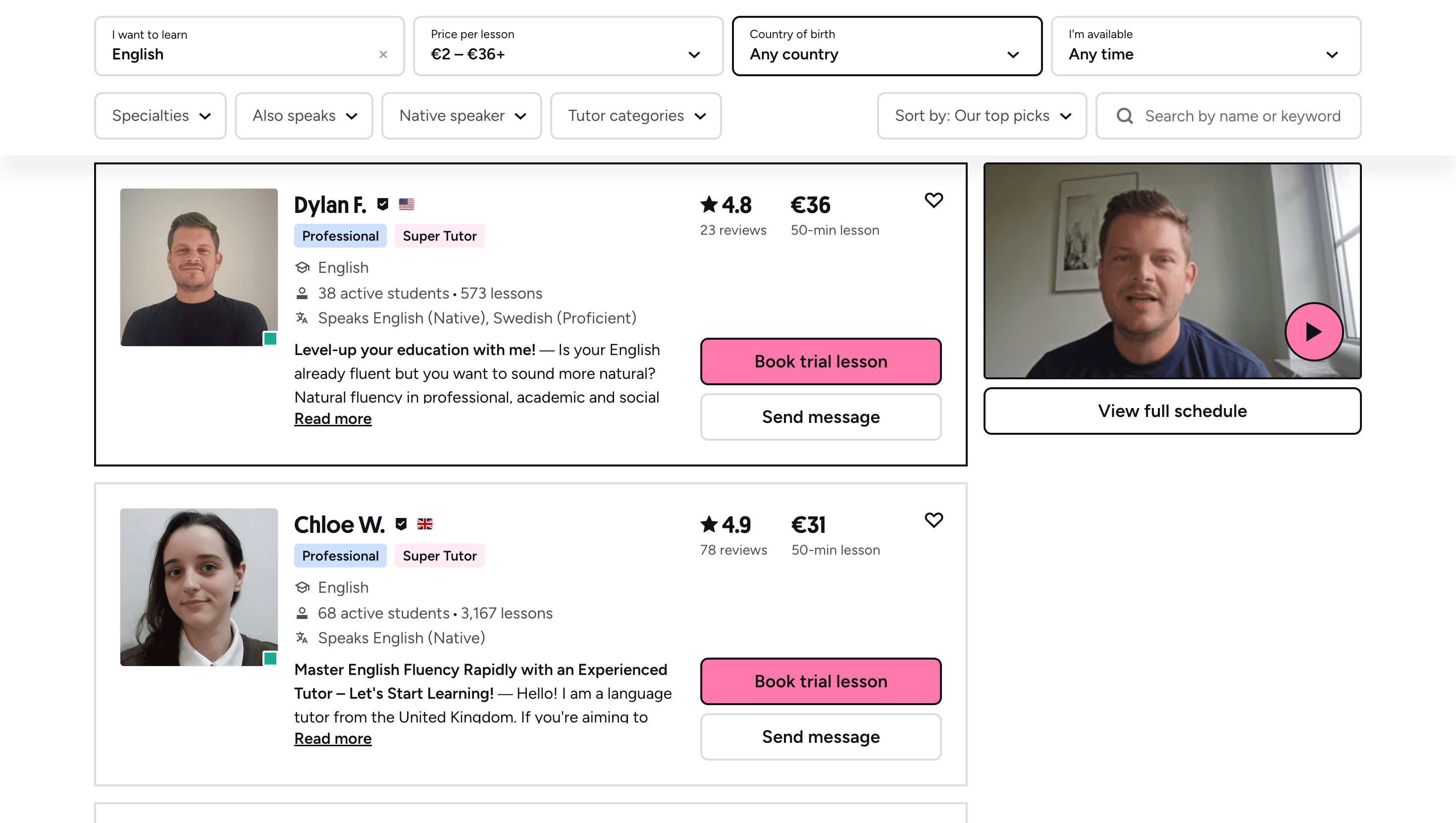
Many learners give up on language learning due to these high costs, missing out on valuable professional and personal opportunities.
That’s why we created Kylian: to make language learning accessible to everyone and help people master a foreign language without breaking the bank.
To get started, just tell Kylian which language you want to learn and what your native language is
Tired of teachers who don’t understand your specific struggles as a French speaker? Kylian’s advantage lies in its ability to teach any language using your native tongue as the foundation.
Unlike generic apps that offer the same content to everyone, Kylian explains concepts in your native language (French) and switches to the target language when necessary—perfectly adapting to your level and needs.
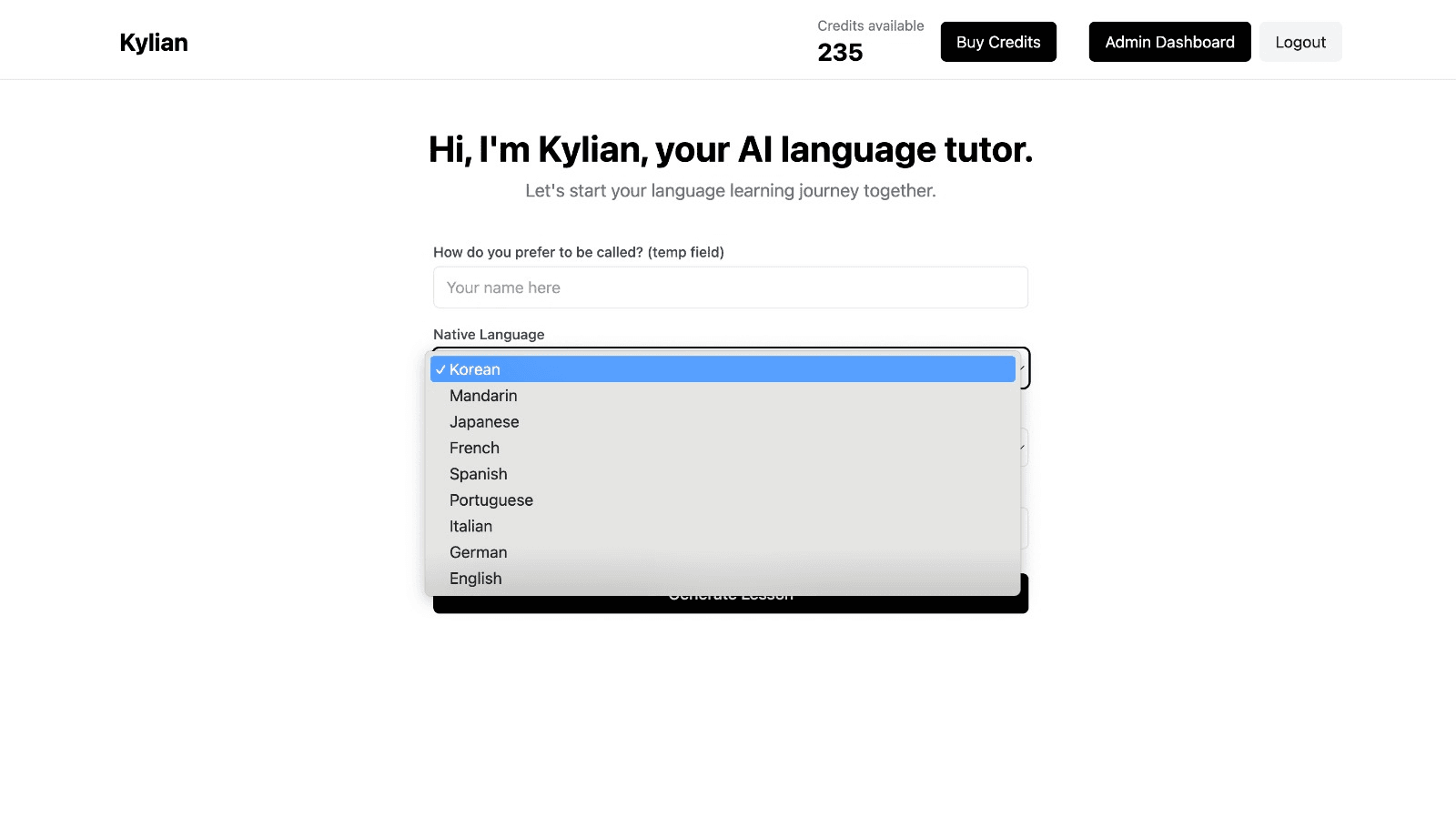
This personalization removes the frustration and confusion that are so common in traditional language learning.
Choose a specific topic you want to learn
Frustrated by language lessons that never cover exactly what you need? Kylian can teach you any aspect of a language—from pronunciation to advanced grammar—by focusing on your specific goals.
Avoid vague requests like “How can I improve my accent?” and be precise: “How do I pronounce the R like a native English speaker?” or “How do I conjugate the verb ‘to be’ in the present tense?”
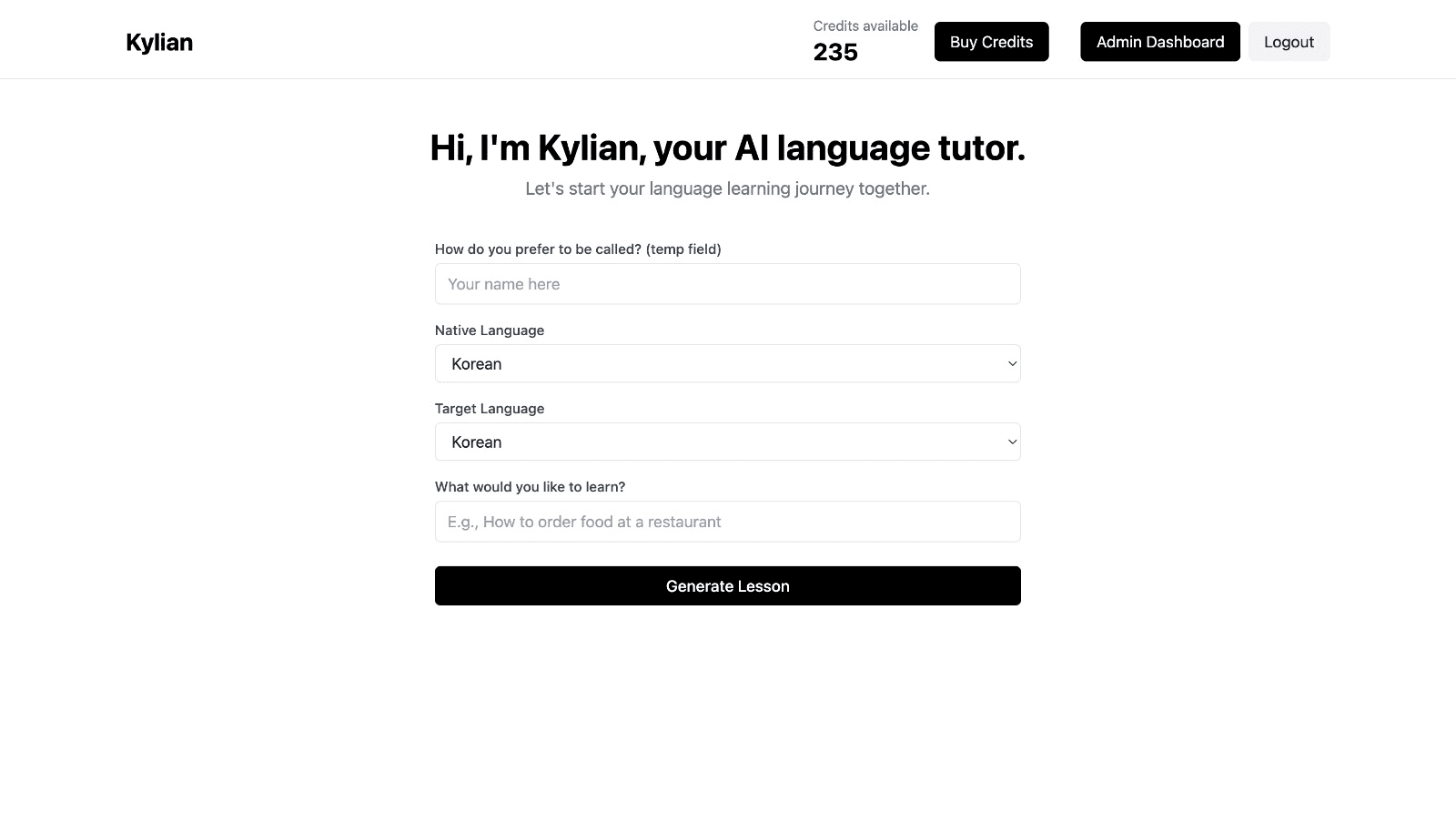
With Kylian, you’ll never again pay for irrelevant content or feel embarrassed asking “too basic” questions to a teacher. Your learning plan is entirely personalized.
Once you’ve chosen your topic, just hit the “Generate a Lesson” button, and within seconds, you’ll get a lesson designed exclusively for you.
Join the room to begin your lesson
The session feels like a one-on-one language class with a human tutor—but without the high price or time constraints.
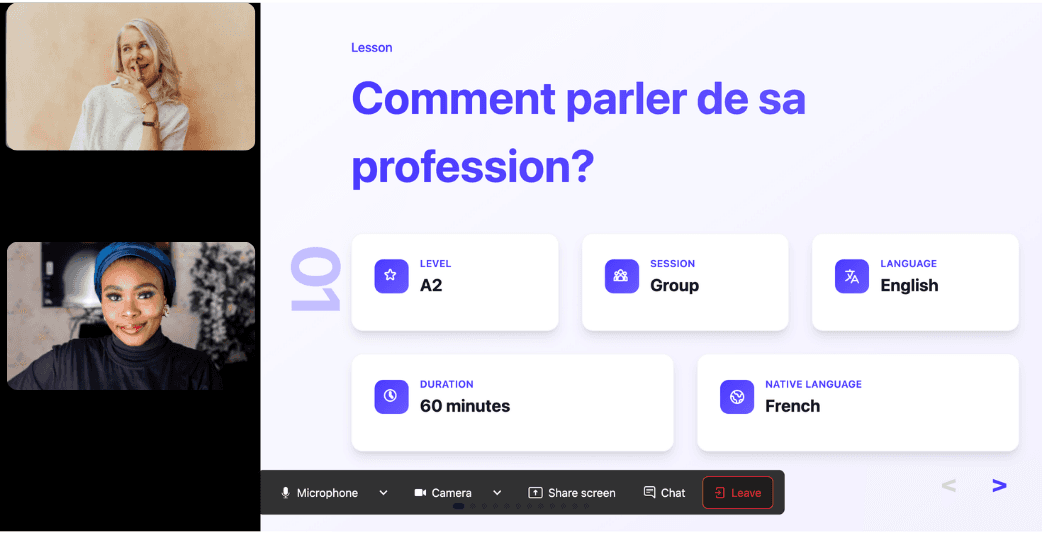
In a 25-minute lesson, Kylian teaches exactly what you need to know about your chosen topic: the nuances that textbooks never explain, key cultural differences between French and your target language, grammar rules, and much more.
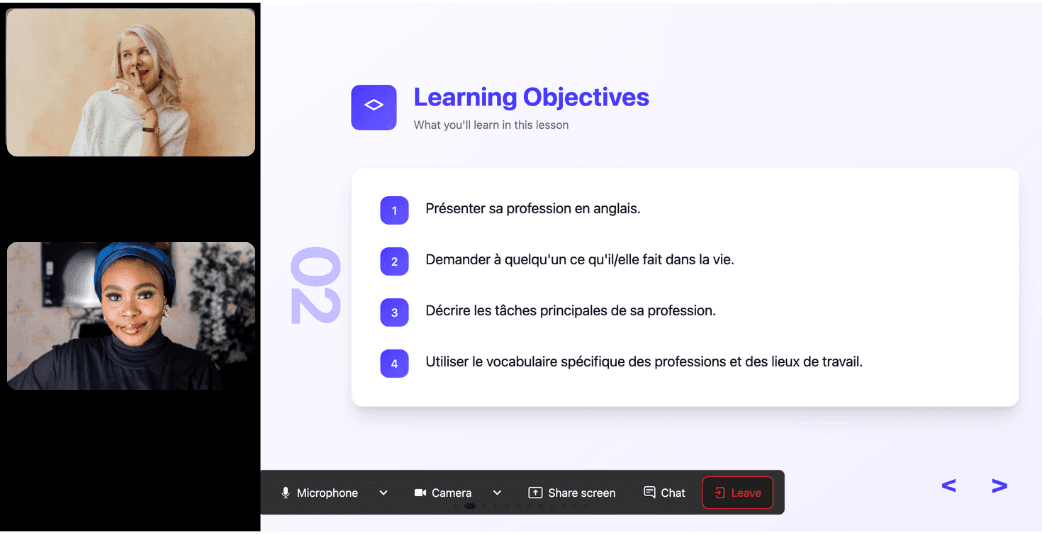
Ever felt frustrated trying to keep up with a native-speaking teacher, or embarrassed to ask for something to be repeated? With Kylian, that problem disappears. It switches intelligently between French and the target language depending on your level, helping you understand every concept at your own pace.
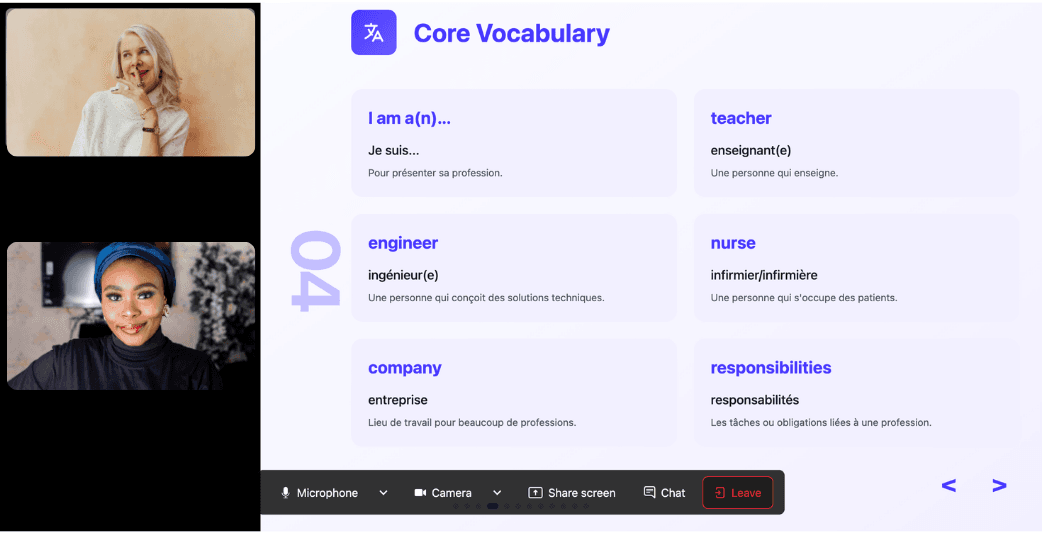
During the lesson, Kylian uses role-plays, real-life examples, and adapts to your learning style. Didn’t understand something? No problem—you can pause Kylian anytime to ask for clarification, without fear of being judged.
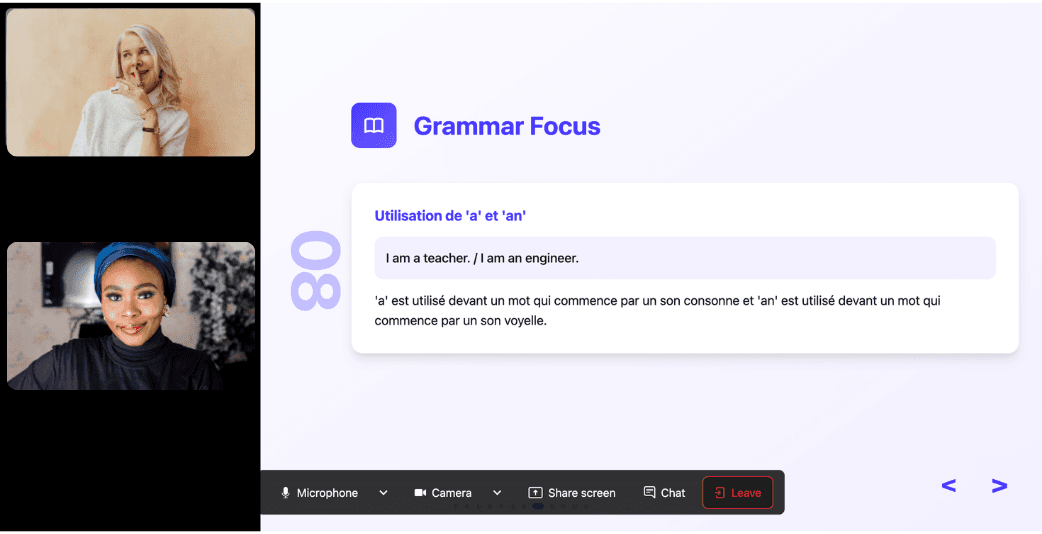
Ask all the questions you want, repeat sections if needed, and customize your learning experience in ways traditional teachers and generic apps simply can’t match.

With 24/7 access at a fraction of the cost of private lessons, Kylian removes all the barriers that have kept you from mastering the language you’ve always wanted to learn.
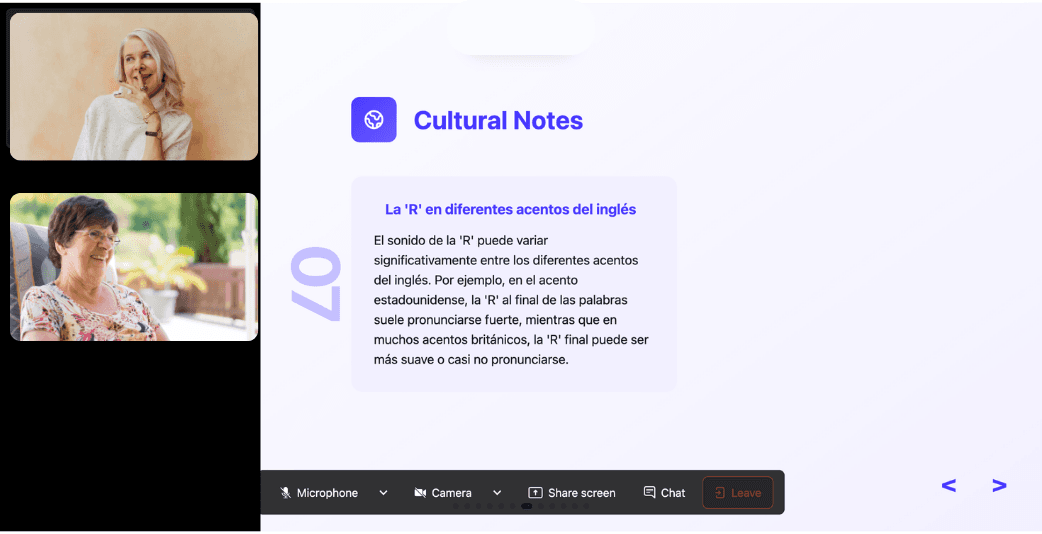
Similar Content You Might Want To Read

The Useful Guide to Saying "Thank You" in Portuguese
In the realm of language acquisition, mastering expressions of gratitude stands as a fundamental milestone. When venturing into Portuguese-speaking territories—whether the bustling streets of Lisbon or the vibrant beaches of Rio de Janeiro—knowing how to properly express thanks transcends mere politeness; it establishes meaningful connection. The Portuguese language, like many Romance languages, incorporates nuanced ways to express gratitude that vary depending on context, relationship, and even the speaker's gender identity. This comprehensive guide delves into the multifaceted approaches to saying "thank you" in Portuguese, equipping you with practical knowledge for authentic interactions.

60 English Verbs for Beginners: Building Your Foundation
Learning English requires a strategic approach. When faced with thousands of words to memorize, knowing which ones to prioritize makes all the difference in your progress. Verbs—the action words that drive your sentences—form the backbone of effective communication. Master the right ones first, and you'll achieve conversational ability much faster.

Rooting For Meaning in English: Practical Usage Guide
Sports fans cheer wildly as their team scores the winning goal. Parents sit anxiously at school competitions, silently mouthing encouragement for their children. Friends send supportive messages before a job interview. These scenarios share a common thread—people "rooting for" someone or something they want to succeed. This expression, deeply embedded in English communication, extends far beyond simple support. It carries emotional weight, cultural significance, and contextual nuances that make it both powerful and occasionally challenging for English learners to master. Understanding when and how to use "rooting for" opens a window into authentic English expression and cultural connection. Let's explore this phrase's meaning, origins, and practical applications—providing you with the knowledge to incorporate it naturally into your English communication.

Master the Spanish Subjunctive: Your Complete Guide
The subjunctive mood in Spanish strikes fear into the hearts of many language learners. Yet, this grammatical feature is essential for anyone seeking to express nuanced thoughts in the world's second-most spoken native language. Without it, communicating doubts, possibilities, emotions, and hypothetical situations becomes nearly impossible. This comprehensive guide will demystify the Spanish subjunctive, transforming it from an intimidating obstacle into a powerful tool for authentic expression. With clear explanations, practical strategies, and relevant examples, you'll gain the confidence to use this grammatical structure naturally in conversation. Ready to elevate your Spanish to the next level and communicate with greater precision? Let's begin.

Biff Slang in English: Definition and Cultural Context
Language continuously evolves, reflecting societal shifts and cultural phenomena. Among the numerous colloquialisms that have entered modern English vocabulary, "biff" stands out as a particularly versatile slang term with multiple interpretations and applications across different English-speaking communities.

"In and of Itself" Meaning and Usage in English
The phrase "in and of itself" appears in approximately 847,000 English texts according to Google Books Ngram Viewer, yet remains one of the most misunderstood expressions in modern English. This prevalence creates a critical knowledge gap—people encounter it constantly but struggle to grasp its precise meaning and appropriate usage. Understanding this phrase matters now because precise communication has become increasingly valuable in professional and academic contexts. When colleagues, friends, or media personalities use "in and of itself," they're making a specific logical distinction that affects the entire argument's validity. Missing this distinction can lead to misinterpretation of critical information.